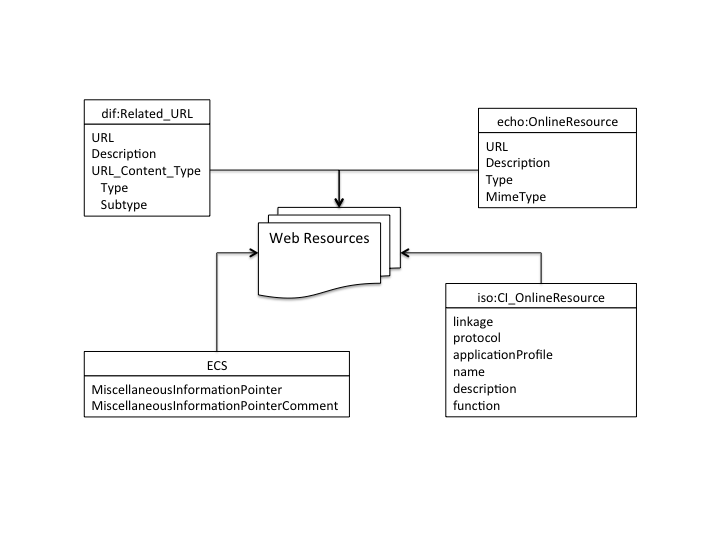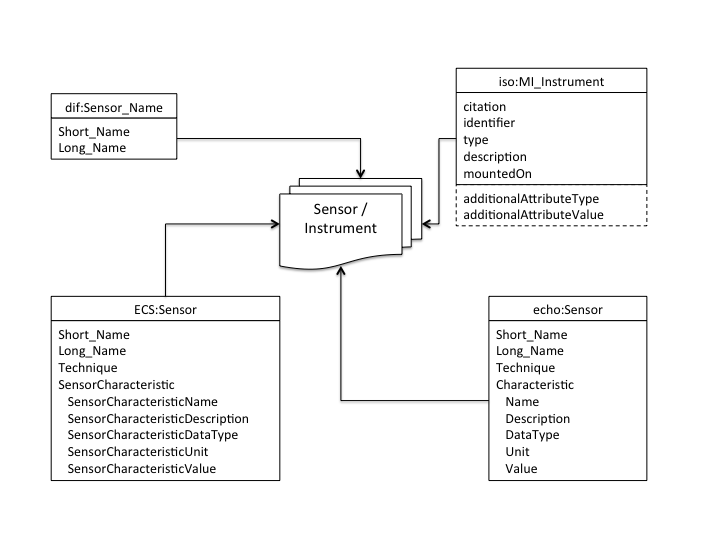Examples
This process is straightforward and many members of the ESDIS Community have extensive relevant experience from fitting together different concepts and data models over many years of interoperability work. Nevertheless, some real-world examples can help clarify the process.
Requirement Addressed - Online Resources
Connections to Web resources are a critical part of any modern metadata dialect. All existing ESDIS metadata dialects (DIF, ECHO, and ECS) include the online resource concept (Figure 2) and all include the essential element of that concept: the URL. They also include the concept of descriptive material that accompanies the URL, termed description or comment. The dialects differ in other details of how the overall concept is described and, therefore, represented in XML.
The ISO Standards also include the concept of online resources and the description is similar to those in the NASA dialects (see Figure). Again, there are small differences and related questions, i.e. how does dif:URL_Content_Type relate to iso:name or iso:function? These differences need to be considered by the community and consensus must be reached in how the details are mapped between the dialects.
Requirement Not Addressed - Instrument and Sensor Characteristics
The characteristics of instruments used to make observations are a critical documentation element for NASA data and products. At the same time, the diversity of instruments used and the even greater diversity of their characteristics make documenting these difficult. This difficulty is reflected in the treatment of sensor/instrument characteristics in existing NASA dialects (Figure 3).
The ECHO and ECS dialects address the diversity of instrument and sensor characteristics by including a data type specifically designed to record important properties of the characteristics (name, description, data type, unit, and value). This allows a fairly robust description of the instrument/sensor characteristics to be included directly in the metadata. The DIF dialect takes a different approach appropriate at the discovery level: it includes only the short and long names of the instrument.
The current ISO approach to describing an instrument (shown in the solid box in Figure 3) lies somewhere in between. It includes an identifier and classification information (type), a brief description, a citation to more information, and a pointer to the platform the instrument is mounted on.
The ISO Standards also include a mechanism for including implementation specific information in the metadata using standard RecordType and Record data types. This mechanism is currently not used for instruments, but the ISO instrument description could be extended by adding additionalAttributeType and additionalAttributeValue elements that would allow the same robust descriptions currently included in ECHO and ECS to be included in the ISO metadata. These extended elements would become part of the NASA Best Practices for ISO.
Conclusion
The process of developing a NASA Best Practices for ISO is straightforward and familiar to many members of the ESDIS community. Existing ESDIS metadata dialects provide structured and well-understood picture of many ESDIS metadata requirements. Developing consensus crosswalks between those dialects and ISO is a good step towards understanding the requirements and identifying those that are and are not addressed by the ISO Standards. In addition, this is an important step towards community engagement because the community is already familiar with these dialects. Working with new missions is another important element in the process.


1 Comment
user-b6eec
Are these pages being kept in sync with the MENDS pages?